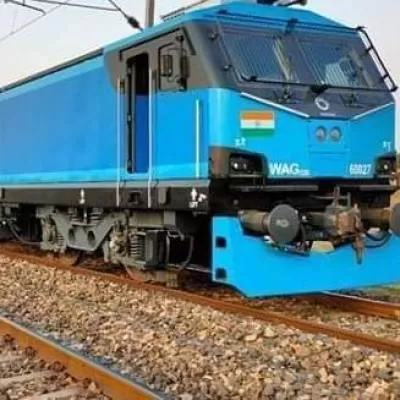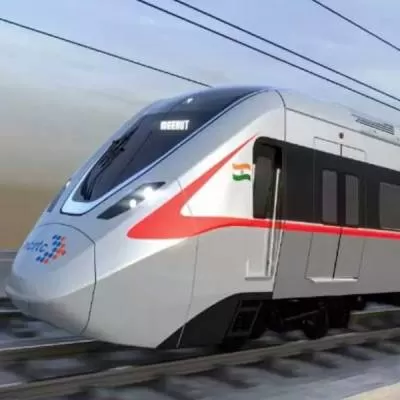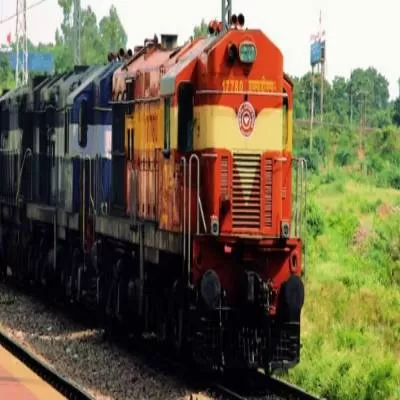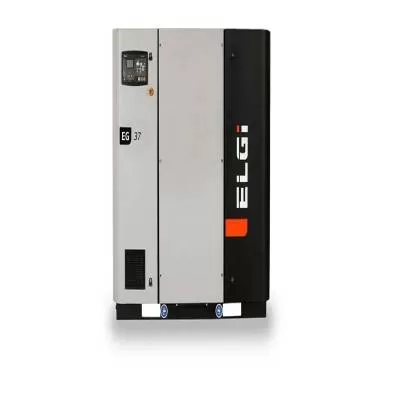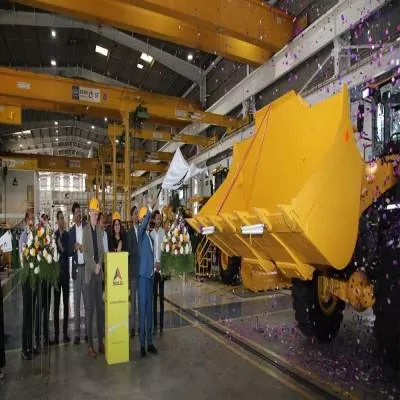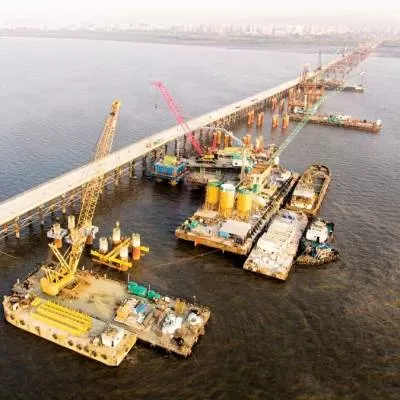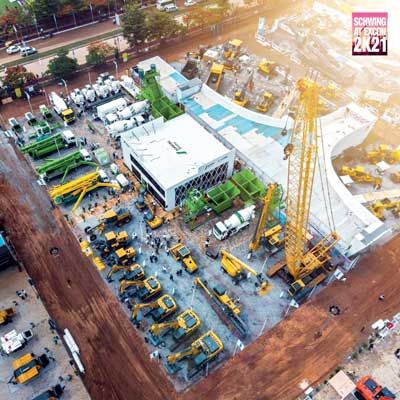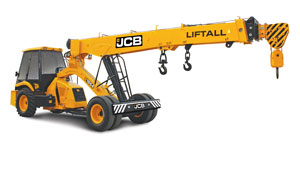
Mobile, but only just
Data estimates peg mobile cranes as the third largest individual segment of the construction equipment market. So, how big is big?
According to Sudesh Dabhekar, AGM-Sales, Hyva India, "Mobile cranes account for 65-75 per cent of the total Indian crane market, pegged between 7,500 and 8,500 units in FY 2012-13. Within mobile cranes, the pick-and-carry variety comprises about three-fourths of the market. Truck-mounted knuckle boom cranes make up 4-5 per cent, crawlers constitute 5 per cent, and others like rough terrain, all-terrain, jib and straight boom loader cranes comprise 15 per cent of the market."
AT Kearney India pegged the Indian market for mobile cranes at 8,500 units in 2012, with the potential to grow to between 14,000 and 18,000 units by 2016. But these estimates will only materialise when demand picks up.
Dull market
At present, industry voices speak in unison about demand being flat, or nearly so. "We have seen no increase in demand in the past few months as the construction sector, which is the major demand driver, remains static," says Santhosh Rao P, Managing Director, Palfinger Cranes India.
"Demand for mobile cranes has remained flat in the recent past because of the persisting liquidity problem and most projects being held up or still to take off," opines Manoj Agarwal, General Manager-Marketing & Head-Mobile Cranes, Escorts Construction Equipment. "With the election round the corner and then the monsoons, we feel the market will remain unchanged for ensuing months. Sentiments will improve if the electorate gives a clear mandate. We expect to see some positive movement with the start of the festive season."
Meanwhile, Ajay Kumar Somani, Director-Mobile Crane Division, Liebherr India Pvt Ltd, says, "Slight positive business movement started in the past two to three months."
And for his part, Dabhekar says, "Demand for knuckle boom cranes is low and has not improved in recent months because the construction industry and infrastructure development are in the midst of a downturn."
Rental demand is charting the same downtrend. According to Tushar Chandrakant Sanas, Director, Sanas Crane, a crane rental company with operations spanning Gujarat, Maharashtra and Karnataka, "Rental demand is down by 40 per cent this year vis-a-vis last year. We are seeing some demand from the windmill power sector, but the usual demand from the steel industry and construction sector is greatly diminished. Current demand is for mobile cranes with capacity between 50 tonne and 250 tonne."
"Rental demand for mobile cranes has dropped owing to the slowdown in construction as well as a growth in the number of suppliers," says Santosh Kumar Tiwari, Vice-President, Marketing & Operations, Sanghvi Movers Ltd. "Providers have even had to cut rental rates to get customers to be able to pay back loans and meet their operational expenses."
Current openings
Lacklustre demand makes it all the more essential for vendors to focus on making the most of every opportunity. Which market segments are still alive?
Currently, Agarwal says the only demand is from metro projects across the country, a refinery project in Gujarat and some assorted handling and construction projects. "Major sectors like mining and power are still down," he adds. "Overall demand hinges on a turnaround in these."
"Interest in new products matches the rate of new projects," says Prem Naithani, Sales Manager in India for Grove mobile cranes and Manitowoc crawler cranes. "Although many large-scale infrastructure projects are on hold over the impending elections, we are seeing demand from road and bridge building, railway projects, and the energy and mining sectors." And Somani shares, "Current demand is from the refinery and cement sectors."
JCB India offers a wide range of construction equipment that includes several models of JCB Liftall pick-and-carry cranes in the mobile crane segment. It started out with two crane variants in the under 12 tonne category and recently launched two more models for big industrial projects with greater lift height and reach. According to Amit Gossain, EVP-Marketing, Business Development and Corporate Affairs, JCB India, "This entry has enabled JCB to become a complete solution provider to its valued customer base, in particular to contractors who undertake civil works and mechanical erection."
It is a smart move. Gossain observes that demand for pick-and-carry cranes has been fuelled by ongoing metro rail projects in cities across India, other infrastructure development projects in urban and rural parts, industrial projects and mining of stone blocks. "Buyers include end-users as well as a category of entrepreneurs known as plant hirers, who purchase pick-and-carry cranes and then rent them out for material shifting, industrial components shifting and construction material shifting," he tells us. "In the rental segment, current demand for crawler cranes comes mostly from the thermal power and refinery sectors," reveals Tiwari. "Metro project developers and windmill operators typically demand truck-mounted cranes because they need mobility. The steel, cement and, lately, solar segment also demand a fair number of cranes. Demand for crawler cranes is higher than that for truck-mounted cranes in the range of 200 MT and above."
After-sales revenues
Players are also trying to boost their revenue through more intense after-sales. "We are trying to increase our after-sales revenue by convincing customers to opt for genuine spares and company-trained service engineers," explains Somani. "We are seeing a very positive response. A large number of customers who were previously opting for cheaper third-party services are now realising that we check cranes more thoroughly and have superior troubleshooting skills than outside agencies. We use sophisticated software to detect current problems and then work on all of them instead of attending to only the specific problem reported by the customer. Moreover, non-company spares come with no working guarantee, no warranty and their genuineness is doubtful."
"Sales is only one part of our efforts," affirms Gurdeep Singh, Head, Manitowoc Crane Care in India. "Servicing cranes is a major area of our work. Our service network covers the entire country. It keeps our cranes running efficiently for longer as well as strengthens customer relationships, our top priority the world over."
Demand patterns
What mobile crane demand trends are manifest in the current addressable market?
According to Tiwari, "Demand for higher capacity cranes is increasing owing to enhancement of thermal power and wind technology. Thermal power companies are constructing the majority of power plants in the supercritical range with ratings like 660 MW and 800 MW and wind power companies are setting up wind farms with ratings of 2.1 MW/3 MW, all of which demand higher capacity cranes in the range of 600 MT/750 MT."
Agarwal sees contractors becoming increasingly conscious about improving site safety standards - "they are aiming at 'zero fatality'," he says. In response to such demand, machines are increasingly boasting safety features such as safe load indicators, GPRS systems, alert devices and cameras. "Major construction companies are already prioritising safety," agrees Rao. "This will eventually cascade down to all customer segments."
"Indeed, users are now demanding better crane safety features and ensure their availability before deployment," adds Tiwari. "Still there is scope to make crane operations safer in terms of proper ground conditions, precautions for working during night time and within very congested sites."
Meanwhile, Somani says, "Demand is rising for mid-sector cranes of capacity between 100 tonne and 300 tonne, in particular for all terrain mobile cranes."
"Road, bridge, and railway projects and the energy and mining sectors demand rugged and versatile mobile cranes that can work long hours in challenging environments," says Naithani. "Our Grove all-terrain and rough-terrain cranes, particularly our strongest five-axle and six-axle units, are popular choices for such demanding work."
Growth opportunities
At present, truck loaders are best classified as an emerging segment. "Being integrated solutions for loading, transporting and unloading, truck loaders offer a valuable proposition in an industry where productivity, time management and safety are top priorities," opines Agarwal. While demand for truck loaders has improved over the years, it is yet to take off vis-a-vis other segments. He believes it will take some more time for the Indian market for truck loaders to mature.
Mature it will, especially because as Rao explains, "Manual labour is no longer seen as the only work method." As construction companies put increasing emphasis on labour savings, he expects the market for truck-mounted mobile cranes to grow.
Opportunities also exist for manufacturers to introduce indigenous models of high-capacity mobile cranes. Observing that India has only two major crane manufacturers offering rough terrain models up to 80 tonne capacity and truck cranes up to 60 tonne capacity, Pradeep Kathuria, Head & CEO, Essar Equipment Bank, sees major gaps in the tyre-mounted mobile crane segment. "Indian users have no choice but to depend on international manufacturers for higher-capacity rough terrain and truck cranes. Also, all terrain cranes are not manufactured in India. The market for 100 tonne, tyre-mounted mobile cranes is large, we believe large enough to justify some manufacturing action among domestic players. There is also scope for improvement in Indian crane manufacturing technology, especially in the design of cranes."
In the crawler crane segment, Kathuria notes that India only manufactures crawler cranes up to 150 tonne whereas the Indian market needs 250 tonne, 400 tonne and 600 tonne cranes in substantial numbers, which are currently being imported.
Sanas would like to see more mobile cranes above 15 tonne being manufactured in India, as "this would lower the cost of ownership and help rental service providers recover the capital expenditure on cranes in less than four years."
According to V Chandrashekar, Vice-President, Procurement & Soma Asphalt Paving Division, Soma Enterprise, "New cranes of higher capacity are expensive because most of them are imported. There is a pressing need to encourage the manufacturing of cranes in India to make them more cost effective or to permit the duty-free import of cranes for critical projects. As things stand, construction companies tend to own only cranes for critical applications. Most erection work is subcontracted, which brings its own challenges. Subcontractors typically own cranes that are about two decades old, to complete the work within costs. Most of these cranes lack safety features and are not in good condition."
Chandrashekar would also like manufacturers to establish schools to train and certify operators to be provided to the construction industry. "That way, we can be assured of enough trained and certified operators to operate cranes," he points out.
Renters' priorities
What are renters looking for?
"Customers in the hiring sector are not looking at long-term gains," observes Somani. "They are price-driven as rental rates are based on capacity not the make. Direct users are becoming more conscious about quality, reliability, performance parameters, after-sales support and safety features such as hand railings on the crane body and a provision for latching the person walking on the boom to prevent a free fall."
"We cater to mostly the hiring sector across the country," adds Agarwal. "Renters are obviously looking for equipment that is fuel-efficient with low operational and maintenance costs."
All considered, matching the priorities of buyers and renters may be a good start to getting the mobile crane market moving again.
To share your views on the mobile cranes market in India, write in at feedback@ASAPPmedia.com
- India
- 2014
- mobile cranes
- construction equipment
- Sudesh Dabhekar
- Hyva India
- knuckle boom cranes
- Santhosh Rao P
- Palfinger Cranes India
- Manoj Agarwal
- Escorts Construction Equipment
- Ajay Kumar Somani
- Liebherr India
- Ajay Kumar Somani
- Sanas Crane
- Maharashtra
- Karnataka
- Prem Naithani
- Gurdeep Singh
- Manitowoc Crane
- Pradeep Kathuria
With just a few sectors contributing to demand for mobile cranes, vendors are taking every opportunity seriously. CHARU BAHRI identifies the market segments where demand is alive. Data estimates peg mobile cranes as the third largest individual segment of the construction equipment market. So, how big is big? According to Sudesh Dabhekar, AGM-Sales, Hyva India, "Mobile cranes account for 65-75 per cent of the total Indian crane market, pegged between 7,500 and 8,500 units in FY 2012-13. Within mobile cranes, the pick-and-carry variety comprises about three-fourths of the market. Truck-mounted knuckle boom cranes make up 4-5 per cent, crawlers constitute 5 per cent, and others like rough terrain, all-terrain, jib and straight boom loader cranes comprise 15 per cent of the market." AT Kearney India pegged the Indian market for mobile cranes at 8,500 units in 2012, with the potential to grow to between 14,000 and 18,000 units by 2016. But these estimates will only materialise when demand picks up. Dull market At present, industry voices speak in unison about demand being flat, or nearly so. "We have seen no increase in demand in the past few months as the construction sector, which is the major demand driver, remains static," says Santhosh Rao P, Managing Director, Palfinger Cranes India. "Demand for mobile cranes has remained flat in the recent past because of the persisting liquidity problem and most projects being held up or still to take off," opines Manoj Agarwal, General Manager-Marketing & Head-Mobile Cranes, Escorts Construction Equipment. "With the election round the corner and then the monsoons, we feel the market will remain unchanged for ensuing months. Sentiments will improve if the electorate gives a clear mandate. We expect to see some positive movement with the start of the festive season." Meanwhile, Ajay Kumar Somani, Director-Mobile Crane Division, Liebherr India Pvt Ltd, says, "Slight positive business movement started in the past two to three months." And for his part, Dabhekar says, "Demand for knuckle boom cranes is low and has not improved in recent months because the construction industry and infrastructure development are in the midst of a downturn." Rental demand is charting the same downtrend. According to Tushar Chandrakant Sanas, Director, Sanas Crane, a crane rental company with operations spanning Gujarat, Maharashtra and Karnataka, "Rental demand is down by 40 per cent this year vis-a-vis last year. We are seeing some demand from the windmill power sector, but the usual demand from the steel industry and construction sector is greatly diminished. Current demand is for mobile cranes with capacity between 50 tonne and 250 tonne." "Rental demand for mobile cranes has dropped owing to the slowdown in construction as well as a growth in the number of suppliers," says Santosh Kumar Tiwari, Vice-President, Marketing & Operations, Sanghvi Movers Ltd. "Providers have even had to cut rental rates to get customers to be able to pay back loans and meet their operational expenses." Current openings Lacklustre demand makes it all the more essential for vendors to focus on making the most of every opportunity. Which market segments are still alive? Currently, Agarwal says the only demand is from metro projects across the country, a refinery project in Gujarat and some assorted handling and construction projects. "Major sectors like mining and power are still down," he adds. "Overall demand hinges on a turnaround in these." "Interest in new products matches the rate of new projects," says Prem Naithani, Sales Manager in India for Grove mobile cranes and Manitowoc crawler cranes. "Although many large-scale infrastructure projects are on hold over the impending elections, we are seeing demand from road and bridge building, railway projects, and the energy and mining sectors." And Somani shares, "Current demand is from the refinery and cement sectors." JCB India offers a wide range of construction equipment that includes several models of JCB Liftall pick-and-carry cranes in the mobile crane segment. It started out with two crane variants in the under 12 tonne category and recently launched two more models for big industrial projects with greater lift height and reach. According to Amit Gossain, EVP-Marketing, Business Development and Corporate Affairs, JCB India, "This entry has enabled JCB to become a complete solution provider to its valued customer base, in particular to contractors who undertake civil works and mechanical erection." It is a smart move. Gossain observes that demand for pick-and-carry cranes has been fuelled by ongoing metro rail projects in cities across India, other infrastructure development projects in urban and rural parts, industrial projects and mining of stone blocks. "Buyers include end-users as well as a category of entrepreneurs known as plant hirers, who purchase pick-and-carry cranes and then rent them out for material shifting, industrial components shifting and construction material shifting," he tells us. "In the rental segment, current demand for crawler cranes comes mostly from the thermal power and refinery sectors," reveals Tiwari. "Metro project developers and windmill operators typically demand truck-mounted cranes because they need mobility. The steel, cement and, lately, solar segment also demand a fair number of cranes. Demand for crawler cranes is higher than that for truck-mounted cranes in the range of 200 MT and above." After-sales revenues Players are also trying to boost their revenue through more intense after-sales. "We are trying to increase our after-sales revenue by convincing customers to opt for genuine spares and company-trained service engineers," explains Somani. "We are seeing a very positive response. A large number of customers who were previously opting for cheaper third-party services are now realising that we check cranes more thoroughly and have superior troubleshooting skills than outside agencies. We use sophisticated software to detect current problems and then work on all of them instead of attending to only the specific problem reported by the customer. Moreover, non-company spares come with no working guarantee, no warranty and their genuineness is doubtful." "Sales is only one part of our efforts," affirms Gurdeep Singh, Head, Manitowoc Crane Care in India. "Servicing cranes is a major area of our work. Our service network covers the entire country. It keeps our cranes running efficiently for longer as well as strengthens customer relationships, our top priority the world over." Demand patterns What mobile crane demand trends are manifest in the current addressable market? According to Tiwari, "Demand for higher capacity cranes is increasing owing to enhancement of thermal power and wind technology. Thermal power companies are constructing the majority of power plants in the supercritical range with ratings like 660 MW and 800 MW and wind power companies are setting up wind farms with ratings of 2.1 MW/3 MW, all of which demand higher capacity cranes in the range of 600 MT/750 MT." Agarwal sees contractors becoming increasingly conscious about improving site safety standards - "they are aiming at 'zero fatality'," he says. In response to such demand, machines are increasingly boasting safety features such as safe load indicators, GPRS systems, alert devices and cameras. "Major construction companies are already prioritising safety," agrees Rao. "This will eventually cascade down to all customer segments." "Indeed, users are now demanding better crane safety features and ensure their availability before deployment," adds Tiwari. "Still there is scope to make crane operations safer in terms of proper ground conditions, precautions for working during night time and within very congested sites." Meanwhile, Somani says, "Demand is rising for mid-sector cranes of capacity between 100 tonne and 300 tonne, in particular for all terrain mobile cranes." "Road, bridge, and railway projects and the energy and mining sectors demand rugged and versatile mobile cranes that can work long hours in challenging environments," says Naithani. "Our Grove all-terrain and rough-terrain cranes, particularly our strongest five-axle and six-axle units, are popular choices for such demanding work." Growth opportunities At present, truck loaders are best classified as an emerging segment. "Being integrated solutions for loading, transporting and unloading, truck loaders offer a valuable proposition in an industry where productivity, time management and safety are top priorities," opines Agarwal. While demand for truck loaders has improved over the years, it is yet to take off vis-a-vis other segments. He believes it will take some more time for the Indian market for truck loaders to mature. Mature it will, especially because as Rao explains, "Manual labour is no longer seen as the only work method." As construction companies put increasing emphasis on labour savings, he expects the market for truck-mounted mobile cranes to grow. Opportunities also exist for manufacturers to introduce indigenous models of high-capacity mobile cranes. Observing that India has only two major crane manufacturers offering rough terrain models up to 80 tonne capacity and truck cranes up to 60 tonne capacity, Pradeep Kathuria, Head & CEO, Essar Equipment Bank, sees major gaps in the tyre-mounted mobile crane segment. "Indian users have no choice but to depend on international manufacturers for higher-capacity rough terrain and truck cranes. Also, all terrain cranes are not manufactured in India. The market for 100 tonne, tyre-mounted mobile cranes is large, we believe large enough to justify some manufacturing action among domestic players. There is also scope for improvement in Indian crane manufacturing technology, especially in the design of cranes." In the crawler crane segment, Kathuria notes that India only manufactures crawler cranes up to 150 tonne whereas the Indian market needs 250 tonne, 400 tonne and 600 tonne cranes in substantial numbers, which are currently being imported. Sanas would like to see more mobile cranes above 15 tonne being manufactured in India, as "this would lower the cost of ownership and help rental service providers recover the capital expenditure on cranes in less than four years." According to V Chandrashekar, Vice-President, Procurement & Soma Asphalt Paving Division, Soma Enterprise, "New cranes of higher capacity are expensive because most of them are imported. There is a pressing need to encourage the manufacturing of cranes in India to make them more cost effective or to permit the duty-free import of cranes for critical projects. As things stand, construction companies tend to own only cranes for critical applications. Most erection work is subcontracted, which brings its own challenges. Subcontractors typically own cranes that are about two decades old, to complete the work within costs. Most of these cranes lack safety features and are not in good condition." Chandrashekar would also like manufacturers to establish schools to train and certify operators to be provided to the construction industry. "That way, we can be assured of enough trained and certified operators to operate cranes," he points out. Renters' priorities What are renters looking for? "Customers in the hiring sector are not looking at long-term gains," observes Somani. "They are price-driven as rental rates are based on capacity not the make. Direct users are becoming more conscious about quality, reliability, performance parameters, after-sales support and safety features such as hand railings on the crane body and a provision for latching the person walking on the boom to prevent a free fall." "We cater to mostly the hiring sector across the country," adds Agarwal. "Renters are obviously looking for equipment that is fuel-efficient with low operational and maintenance costs." All considered, matching the priorities of buyers and renters may be a good start to getting the mobile crane market moving again. To share your views on the mobile cranes market in India, write in at feedback@ASAPPmedia.com


